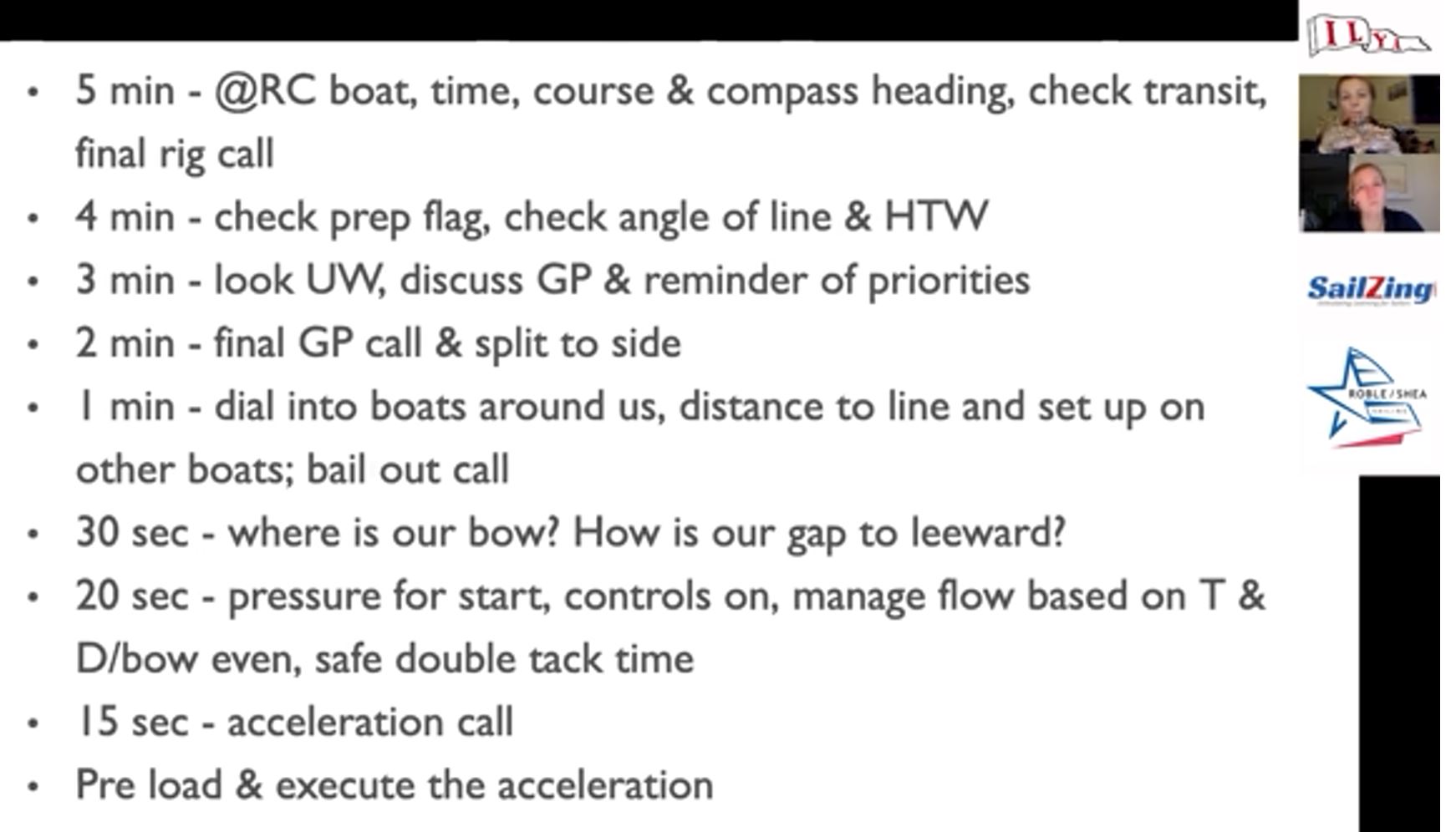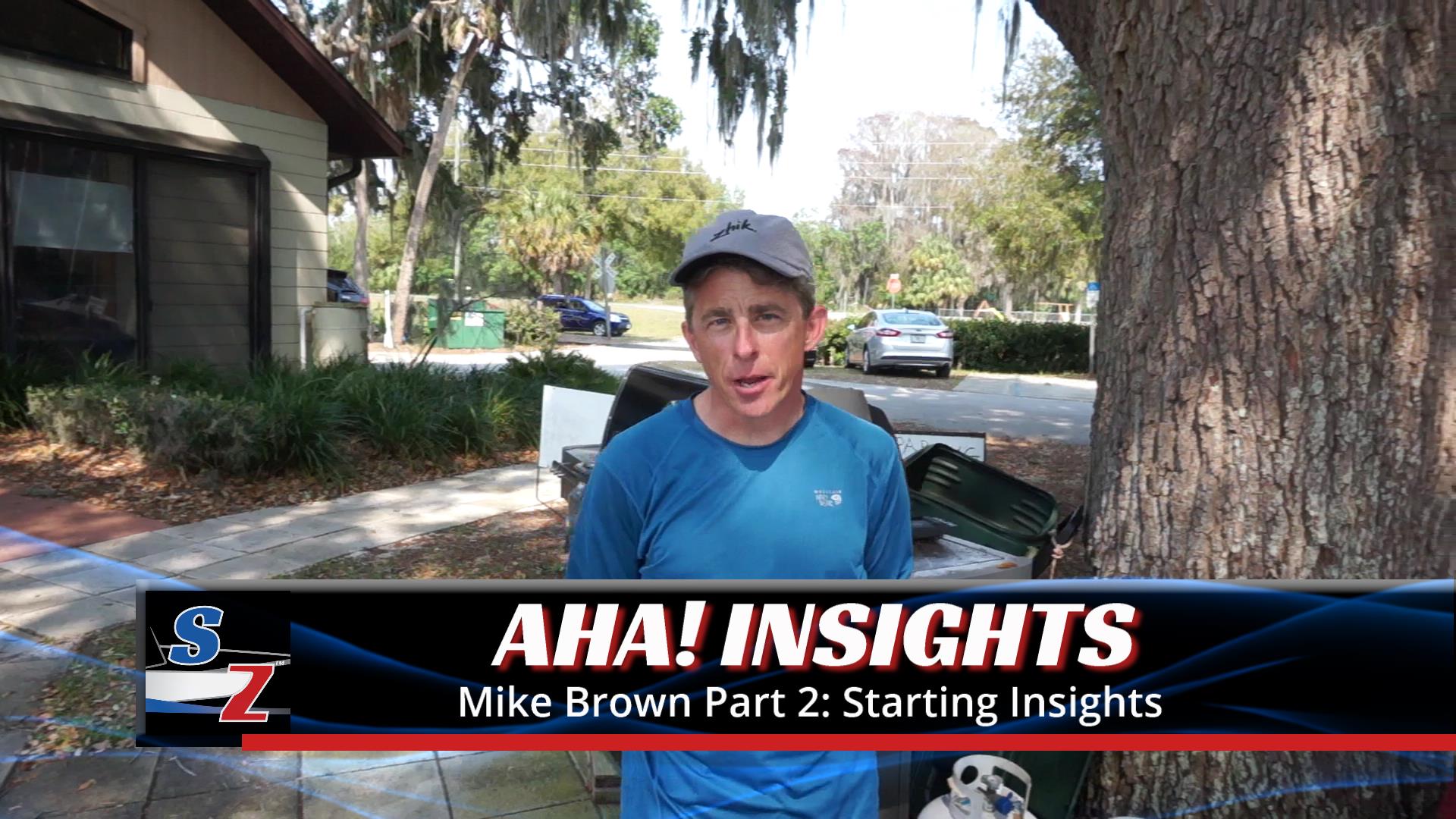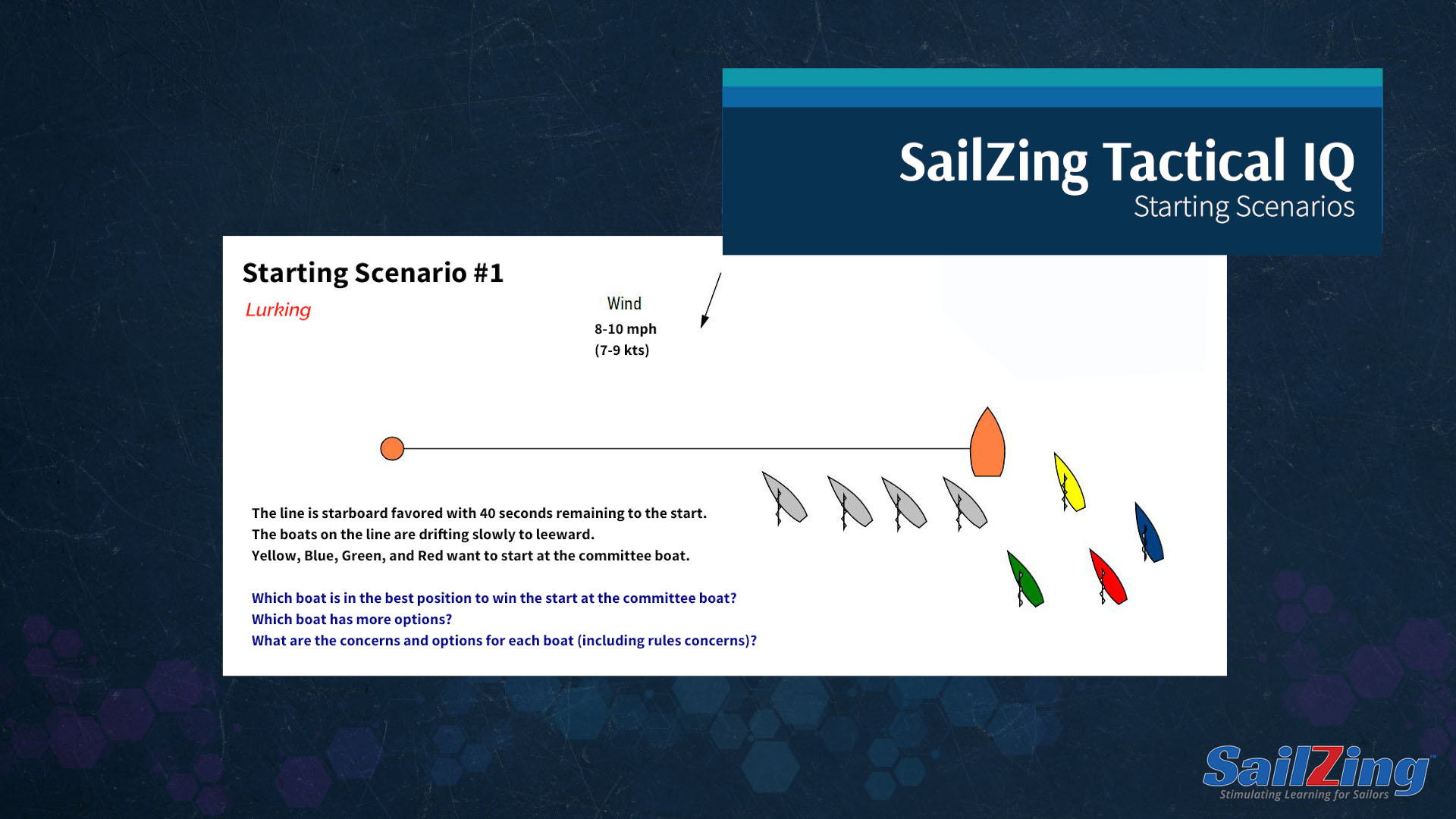This article has been updated.
If you rank racing skills by degree of difficulty and potential for gain/loss, big fleet starts are at or near the top. In small fleets, it’s easier to get a good start and if you don’t, it’s easy enough to recover. Not so in big fleets. Furthermore, big fleet starts are hard to practice outside of regattas.
For this post, we pulled together tips from several sources, including 10 Moves That Don’t Work in a Big Fleet (George Szabo in Sailing World), Successful Starting in Big Fleets (Bill Hardesty in Scuttlebutt Sailing News), How to Win in a Big Fleet (Toby Heppel, Yachts and Yachting), and Size Matters: Tips for Starting in Big and Small Fleets (Clay Johnson in Center of Effort Blog).
Challenges of Big Fleet Starts
If you understand the challenges of big fleet starts, you can start to deal them. Here are six challenges:
- Starting at the ends is risky. If you pick the wrong side, recovery will be tough.
- Long starting lines are often farther offshore, making line sights more challenging.
- Time to sail the length of the line is long, making it difficult to change your mind.
- Boats claim their starting position earlier, so it’s easier to get shut out.
- Hard to recover from being over early and having to re-start.
- The wind is chopped up from all the boats. This affects boats in the front row but is much worse for those behind.
This is a great video by Sailing World‘s Mike Ingham talking about Big Fleet Strategies and Tactics from Lake Garda, Italy during the 94-boat 2022 Sunfish World Championship.
Priority Techniques and Precautions in Big Fleet Starts
Sailors with good starting techniques will do well in any size fleet. The rest of us need to prioritize certain skills and take extra precautions in a big fleet. Here are eight priorities to consider.
#1. Start in a less dense area
It’s hard to hold a lane in a crowd. Unlike a small fleet, you can’t always tack away and get to a new lane quickly. So, prioritize avoiding the crowds.
#2. Consider starting in the middle
Except in very light air light air or when there’s a clearly favored side, the middle is often a good bet in a big fleet. The middle allows you to see which side may be paying off and get there. You can also often take advantage of line sag. However, the middle has some disadvantages:
- Because of the number of boats, the air will be lighter in the middle than on the ends.
- Unless there is a midline boat to round, being over early is a killer.
Note the huge line sag in this line with 70 Melges 15 boats.
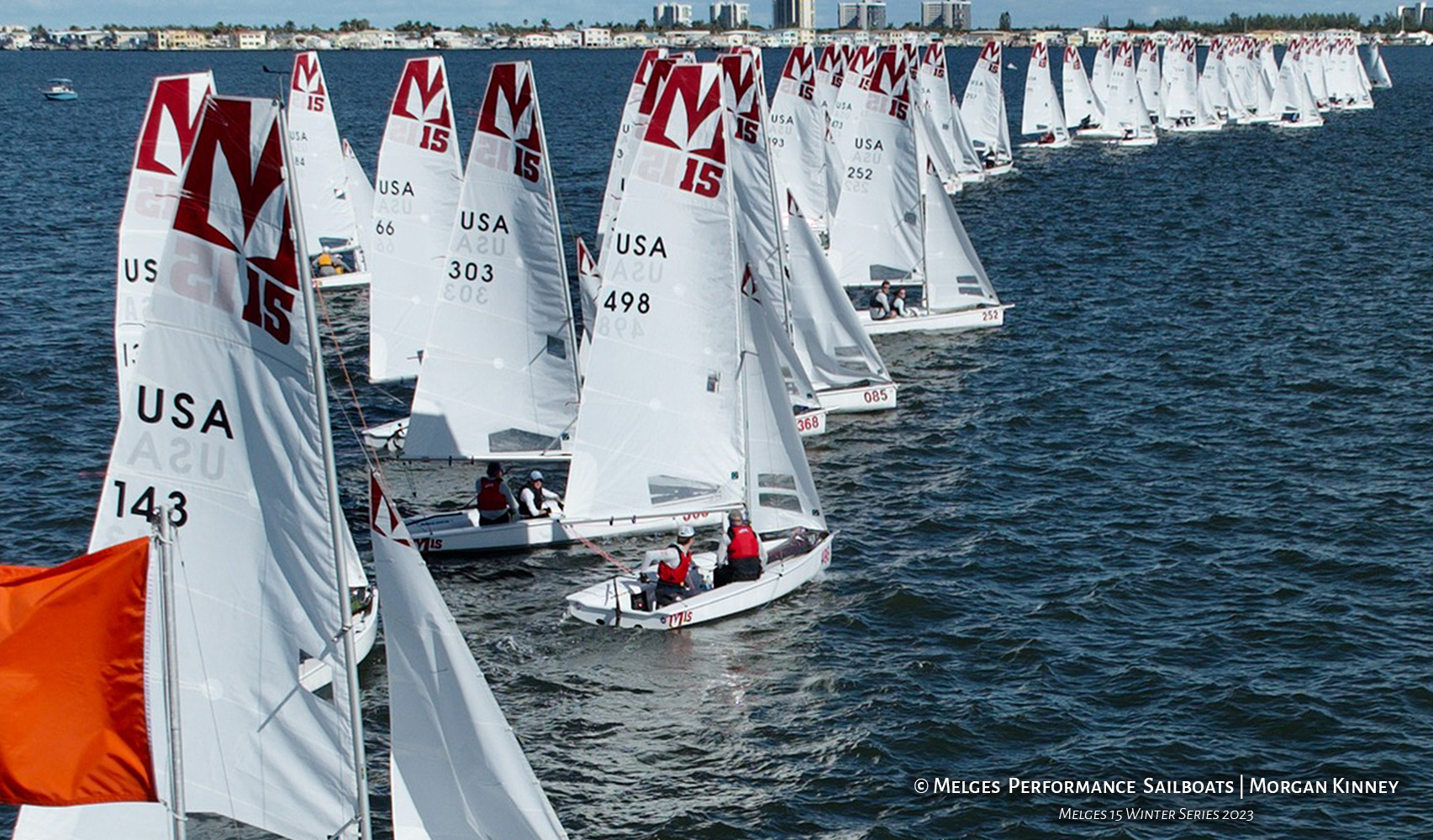
#3. Get a line sight and use it
It’s more difficult to use a line sight in big fleets, but the effort pays off if there’s line sag. A starting penalty (Black, Z, or U flag) makes line sag even more likely. However, if you’re in the middle of the line, it could be very costly to be over and have to round an end.
Getting a line sight can be hard with a long line, so being at least bow even on the windward boat may be the fallback plan. Beware the you could be slightly bow forward of the windward boat but still be way off the line.
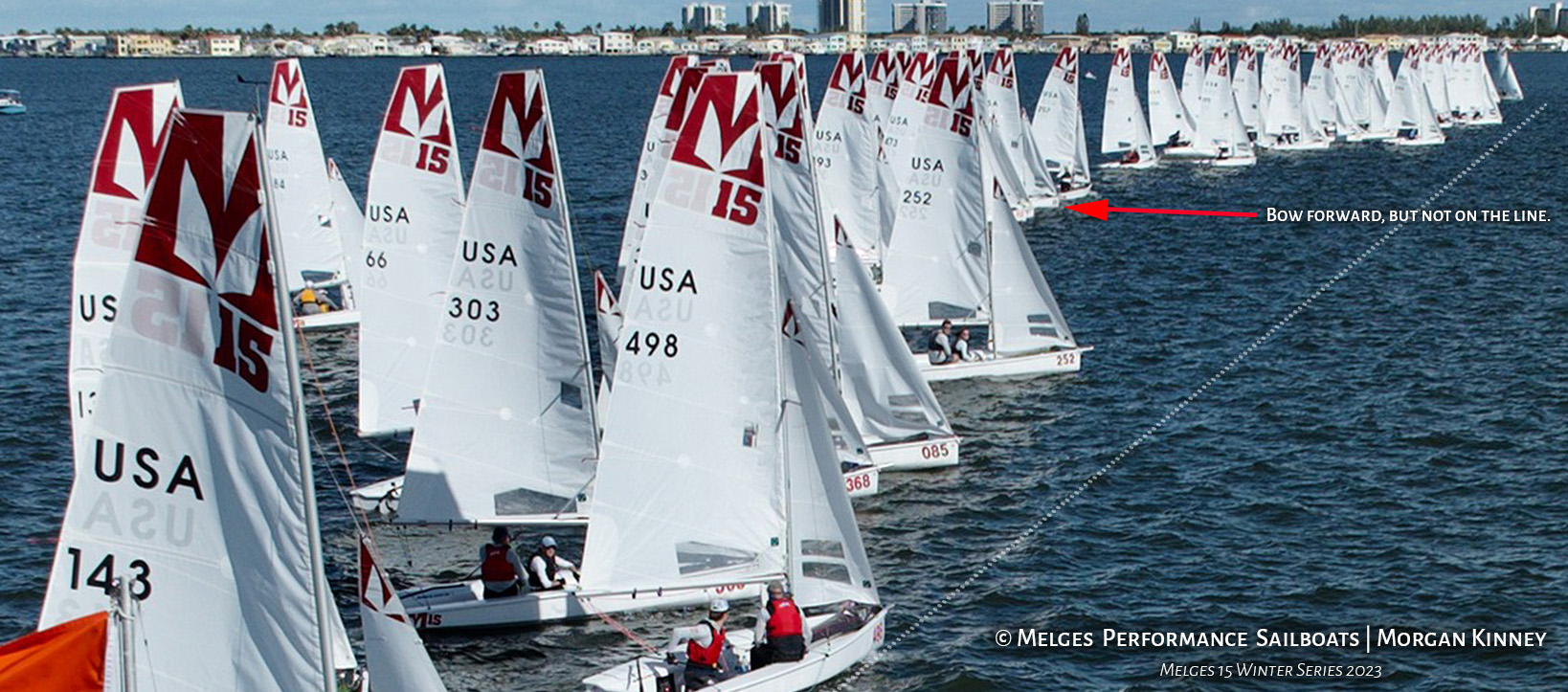
If you have a race computer that enables distance to line, it can take too long to ping both ends and get into position on a really long line.
#4. Set up earlier
Boats will set up earlier in a big fleet, perhaps as early as 1-2 minutes before the gun. Do not wait and get locked out. A port tack approach may make it easier to find a hole.
Review our Starting Line Approach article for insights into different techniques:
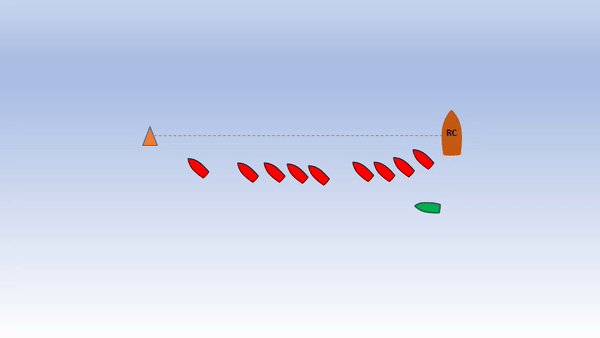
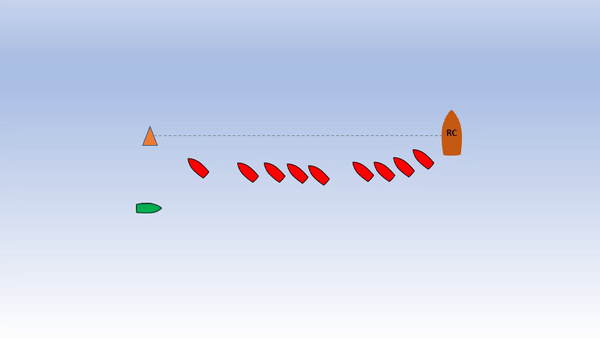
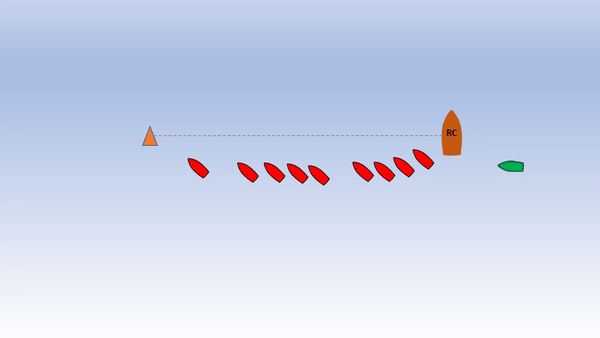
Actual Race Example
The following videos show Mike Schroff (Electric Pickle Racing) and crew Emily Shanley Roberts positioning, communicating, hovering for about 45 seconds on the line starting at around -1:15 to the gun. Note the verbal and visual cues provided by Emily.
- 0:02 – Flat hand stop motion when she wants Mike to stop forward motion
- “I’m gonna look forward” plus hand motion forward – handoff to Mike to watch for boats attacking from behind.
Looking Backward:
Looking Forward:
#5. Defend your gap aggressively
Since you’re setting up early, you’ll have to work hard to defend your gap. Keep your boat moving (& maintain flow) so you can use the techniques – discouraging attackers, shooting up, crabbing to windward, and double tacks.
This from Olympians Roble / Shea Sailing:
- Control the boat to windward – head them up, be bow forward…
- Try to maintain gap below and avoid fouling leeward boat.
Actual Race Example
The following videos show Mike and Emily defending their spot. Note the verbal and visual cues.
- 0:09 – Emily calls out #155 and points at an attacking port approach boat. Mike immediately bears off towards the attacker making the hole less attractive and cutting off #155 & #158 clear astern.
- 0:15 – Emily: “Up, up, up, up” – signaling to move up into gap
- 0:22 – Mike clearly warns boat astern (#155) not to try to take the spot next to him
- Emily: “I’m gonna look forward” plus hand motion forward – handoff to Mike to watch for boats attacking from behind.
- Emily is constantly watching for distance and position to line and guiding Mike while periodically creating flow on her jib to bring bow down.
Looking Backward:
Looking Forward:
Emily is constantly watching for distance and position to line and guiding Mike while periodically creating flow on her jib to bring the bow down. Mike says that Emily also guides him on flow in main.
- Starting: Shooting Up to Maintain Your Gap
- Defending Your Gap – Sailing World – May be harder to do in a big fleet with little room.
- Starting Mentality: Learn to Be Aggressive – SailZing
- Starting Line Approach: What Kind of Creature Should You Be …
- Communications During Approach – Interesting, quirky video demonstrating communications
#6. Power up
With the wind chopped up, set your controls for more power than the clear air conditions on the course call for.
#7. Nail the acceleration
The last 20, 10 and down to 5 seconds before the gun are the most important in the race, depending on the breeze and traffic. Know how long it takes to accelerate to full speed in a range of breezes. You can either cross the line at speed with clear air or be forced to consider a recovery. Start accelerating before nearby boats, especially if you have adequate distance to the line. At the latest, start accelerating when boats around you go, and don’t let them get bow out on you. Watch the boats to windward and try to achieve a lee bow advantage on the windward boat. Watch for the leeward boat to try the same to you. The leeward boat could stall you and you will be in the windward boat’s wind shadow.
Actual Race Example
Mike and Emily tighten up and accelerate through the starting gun. Note that they are both constantly looking around (head on a swivel) for distance to line and position of other competitors.
#8. Smart recovery
A bad start requires a smarter response in a big fleet. You don’t want to get bounced around and still end up in bad air. Choose wisely from the major options: bailout before the start, patient bailout, prompt bailout, stay put or foot off. If you get pushed back into the fleet, there may be no good air, so consider getting to an edge and try to minimize tacking in bad air.
Again…Be Aggressive (within the rules).
This is an excerpt from our article on Starting Mentality:
Fear of mixing it up
Maybe you are a newer sailor and don’t want to mix it up with the veterans. Perhaps you’re uncertain about the rules, worried about fouling someone, or just lack confidence in your boat handling skills. This mentality is hard to change; you only get over it by trying something different.
- Until you get confident, find a low density area to start in. A good start in clear air away from the favored end often beats a bad start at the favored end. Don’t try to start next to an ace sailor.
- Learn the rules associated with starting. They’re not difficult. Focus on the rules associated with starting.
- Practice slow speed boat handling skills. You don’t have to master them all at first. In order of importance: heading up to create space to leeward, stopping/slowing down, accelerating, holding the boat in one spot, sliding the boat to windward, sailing backwards.
- Once you learn the rules and basic skills, don’t be shy about using them. The start is not the time to be nice. If the windward boat won’t head up, don’t be afraid to protest, or at least let them know you won’t stand for it.
- Defend your gap actively. There are a few simple techniques – use them.
- Don’t let another sailor bully you if you try to slide into a gap. Stay within the rules, but be brave and don’t feel bad if you get yelled at.
Summary
A bad start can change your fortunes for the rest of the race. They can make you doubt your sailing and certainly make it hard to hit the podium. In a large fleet, recovery is that much harder, with no clear lanes, bad air, etc. Work hard to build the skills to maximize the likelihood of a solid start.
